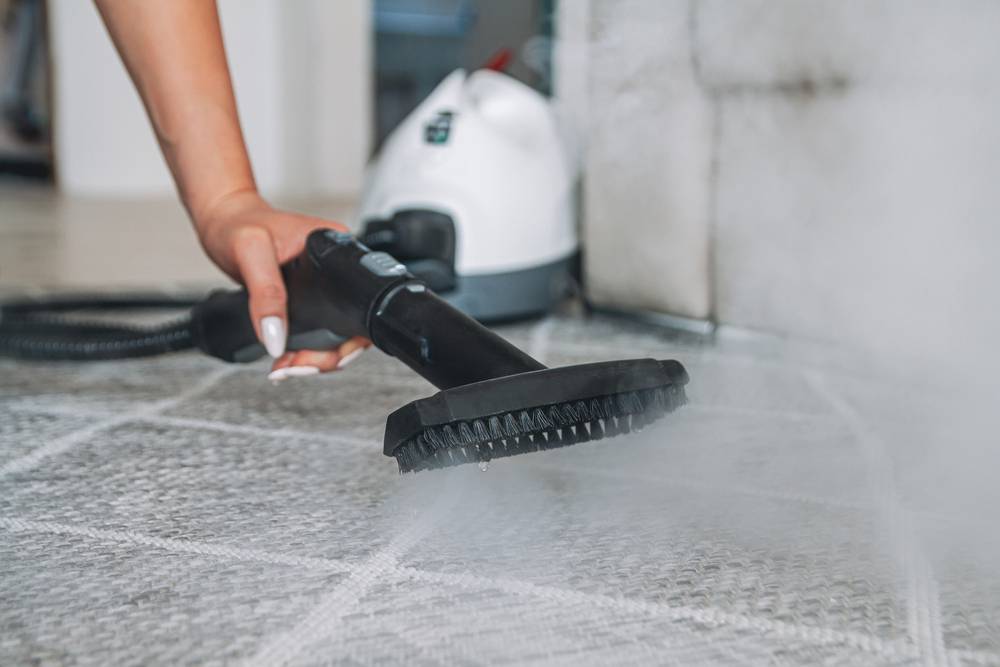Guide To End Of Lease Carpet Cleaning
POSTED ON September 15, 2023
Guide on carpet cleaning when the lease ends. Explore carpet types, DIY and Professional cleaning methods, costs and tips to get your rental bond back.
Understanding Carpet Fibers and Their Cleaning Needs
Carpets consist of various fibres, each with distinct characteristics and cleaning needs. Common fibres are nylon, polyester, olefin, and wool. While nylon is durable, wool is luxurious but demands gentle cleaning. Recognising your carpet's fibre type is crucial for effective cleaning. Carpets vary as much as the homes they grace. Their fibres determine their care needs.
Natural Carpet Fibers
Natural fibres, like wool, cotton, and silk, are the aristocrats of the carpet world. They are delicate and demand gentle cleaning to maintain natural beauty and structure.
- Wool: Soft and durable, wool carpets and rugs resist stains but can be sensitive to alkaline cleaning agents. Avoid using hot water as it may lead to shrinking and can also potentially cause the colours to bleed.
- Cotton: Breathable and gentle, cotton carpets or rugs may wear out in high-traffic areas. Avoid using hot water to preserve the material if your carpets are made of 100% cotton fibres. They are recommended to be dry cleaned once or twice a year, and if you get a stain or mark on your carpet or rug, spot-wash it as quickly as possible.
- Silk: The pinnacle of luxury, silk carpets are soft and shiny but require special care.

Synthetic Carpet Fibers
Carpets made of synthetic fibres, including nylon, polyester, and olefin, are durable and often more affordable. They can withstand rigorous cleaning.
- Nylon: Durable and resistant to wear, nylon carpets are ideal for high-traffic areas. They're also relatively easy to clean.
- Polyester: Soft with vibrant colours, polyester resists stains but can wrinkle if not maintained.
- Olefin: Water-resistant and tough, these carpets are often used in basements and outdoor areas.
Key Considerations for End of Lease Carpet Cleaning
Rental agreements often require properties, including carpets, to be returned to their initial condition. One primary reason tenants choose professional cleaning is to secure their bond return. Clean carpets enhance a property's appeal.
One of the primary reasons tenants opt for professional carpet cleaning is to ensure they get their bond back. Organising a professional cleaning service for the carpeted areas ensures the next tenant enters a hygienic environment. Over time, carpets accumulate dust, dirt, allergens, and pests. Stains, from red wine to pet accidents, can be challenging.
Clean carpets enhance the overall look of a property, making it more appealing to future tenants or buyers.
DIY vs. Professional Cleaning
With your rental deposit at stake, doing your carpet cleaning is quite a risky alternative. However, many tenants choose to go down the line of cleaning; we are eager to share our expert tips and tricks to help them.
DIY Cleaning Guide
- Preparation: Remove furniture and vacuum the carpet thoroughly.
- Stain Treatment: Pre-treat any visible stains with a suitable stain remover.
- Cleaning: Choose a cleaning method depending on the carpet type and the soiling level. Always do a patch test first.
- Drying: Ensure proper ventilation to speed up the drying process and prevent mould growth. Regular vacuuming also helps in preventing mould and mildew. After any wet cleaning method, ensure the carpet dries thoroughly. Using fans, opening windows, and providing proper ventilation can help.
DIY Carpet Cleaning Tips from Experts:
- Baking Soda and Vinegar: Nature offers many cleaning solutions for carpets. Ingredients like baking soda, white vinegar, and essential oils can work wonders, offering a chemical-free cleaning option.
- Spot Treatment: Accidents happen. When they do, it's essential to act swiftly. For spills, blot with a clean cloth working your way from the outside in. Avoid rubbing, as it can deepen the stain.
- Regular Vacuuming: Vacuuming is like a daily exercise for your carpet, preventing deep-set dirt.
Renting a Carpet Steamer
Hiring a steamer for the carpets is generally more affordable than hiring a professional service, making it a good option for those on a budget. Ideal for light cleaning or low-traffic areas, rental steamers are user-friendly.
However, they might be less effective for deep cleaning. Because of their lower pressure, the available steamers are ineffective for removing deep-seated dirt or stubborn stains, especially when your rental bond is at stake.
Another important consideration is that the steamers are less powerful than the professional-grade ones; they might not extract as much water, leading to longer drying times and potential mould growth.

Deep Carpet Cleaning - Professional Methods
While DIY cleaning has its place, professionals offer expertise, advanced tools, and tailored solutions. They recommend a deep clean annually. They can also provide protection treatments to prevent future stains. Even with regular care, carpets need a deep cleaning regularly. Professionals recommend deep cleaning at least once a year to remove embedded dirt and refresh the fibres.
- Hot Water Extraction Method (HWE) or Steam for Carpet Cleaning
HWE involves injecting hot water under high pressure and a cleaning solution into the carpet and extracting it using powerful suction.
- Dry Cleaning
Ideal for delicate fibres, dry cleaning uses chemical solvents to clean the carpet without using water, ensuring no drying time.
- Truck-mounted Steam Cleaning
A step up from regular steam cleaning, truck-mounted systems are more powerful, ensuring a deeper clean and faster drying times. However, this method is suitable for houses with a close driveway.
Professional Carpet Cleaning When Leaving A Rental
Organising a Professional cleaning service to clean the carpets thoroughly is a no-brainer when your lease ends. A few of the reasons why we recommend you choose professionals
- Efficient cleaning
Carpet Steam Cleaning providers using hot water extraction methods provide a thorough cleaning, reaching the base of the carpet fibres and removing ingrained dirt.
- Experience and Expertise Save Time
Powerful water extraction from the carpets reduces the risk of mould and mildew. Professionals have the knowledge to treat different stain spillages according to the carpet types and know which areas your landlord will pay attention to when inspecting the premises clean-wise as your rental lease ends.
- Guaranteed Bond Back with an Invoice
They provide an invoice as proof of service, which serves as proof for your landlord and is especially important for ensuring you will get your rental bond back in full.
- Budget Considerations
Hiring a professional service can be more expensive than renting a machine. Still, the advantages of saving time and the expertise of the pros are worthwhile compared to risking your rental bond.
Expert Carpet Cleaning Tips for Tenants Moving Out
While it might be tempting to clean the carpets yourself and save some money, there are benefits to choosing a professional carpet cleaning service provider. Choosing a professional service ensures thorough cleaning that meets your rental agency's expectations. Here are a few key points to consider before you arrange your professional carpet cleaning service:
Check Your Lease
It might specify cleaning requirements or suggest service providers.
Get Quotes
Compare prices from various providers.
Some of the questions we recommend you ask your chosen cleaning companies:
○ Are they vacuuming the carpets, and is it included in the price estimate?
○ How are you estimating the price? Is it based on square footage/meters or per room?
○ Are there any additional charges related to stain treatment?
○ Are there any additional fees you might have to cover on the day?
(such as parking or price adjustments that are confirmed on the spot)
Ask for a Receipt
Once the cleaning is done, ask for a receipt. It will serve as proof for your landlord or property manager as proof of cleaning.
How Does Our Professional Carpet Cleaning Process Work?
Step 1: Assessment.
Before starting, the cleaners will inspect the carpet to determine its condition and the type of fibres. This helps them decide the most suitable cleaning method to achieve the best results.
Step 2: Vacuuming.
The most important step before cleaning the carpets is always vacuuming, allowing us to remove as much as possible from the surface dirt, dust, and debris accumulated during the lease.
Step 3: Carpet Pre-spray.
Professional Carpet Cleaning solutions contain enzymes capable of loosening the dirt and breaking down any built-up soiling. Pre-spraying is a crucial step for the best possible final result.
Step 4: High Traffic Areas and Stain Treatment.
Any noticeable stains will be pre-treated with specialised products according to the nature of the stains. The high-traffic areas are pre-treated in the same manner.
Step 5: Cleaning.
Depending on the carpet type and level of soiling, the cleaners will either steam clean using the hot water extraction method or, if the carpets are made of delicate fibres - we will use solvent-based cleaners to dry clean the carpets.
FAQs
Q: Is End-Of-Lease Carpet Cleaning Mandatory?
A: The Rental Lease Agreement may dictate your specific carpet cleaning terms. Some landlords mandate a cleaning fee, while others expect clean carpets upon vacating. Landlords shouldn't enforce a specific cleaning company nor indicate bond deductions for covering carpet cleaning expenses.
Q: How Much Does End-Of-Lease Carpet Cleaning Cost?
The end-of-lease carpet cleaning could cost $100 - $200 for most apartments. The price severely depends on the size of the area, the condition of the carpets, as well as the cleaning method used. You may save on the costs by organising a complete end-of-lease cleaning for your rental property, along with carpet cleaning.
Q: Can I Do the End-Of-Lease Carpet Cleaning Myself?
A: Tenants can choose DIY carpet cleaning or hire experts. The main aim is to leave the carpets free of dirt, stains, and damage. Landlords should expect usual wear and tear.
Q: How Long Does the Carpet Take to Dry After Cleaning?
A: Drying times depend on the method. Steam cleaning takes 2-24 hours, while dry cleaning leaves carpets instantly dry. Proper ventilation and airflow of the premises would inevitably speed up the drying process.
Q: What If the Carpet Gets Damaged During Cleaning When You're Moving Out?
A: Suppose a cleaning provider damages the carpets during the end-of-lease cleaning. In that case, the tenants should inform the landlord or their property manager as soon as possible, as the lease terms may dictate repair responsibilities. Always opt for insured and reliable cleaning companies to prevent risks related to rental deposit deductions.
Making the Smart Choice for End of Lease Carpet Cleaning
In this guide, we've explored the complexities of end-of-lease carpet cleaning. From understanding the different types of carpet fibres to weighing the pros and cons of DIY vs. professional cleaning, the choice ultimately depends on your needs and lease requirements. With this comprehensive guide, you're now equipped to make an informed decision that could ensure a full bond return.
Are you ready to book a carpet cleaning service? Contact our Sales Team to save your spot.





